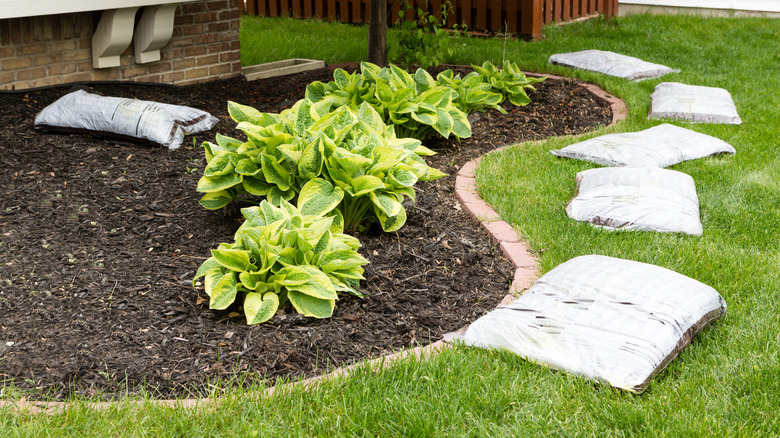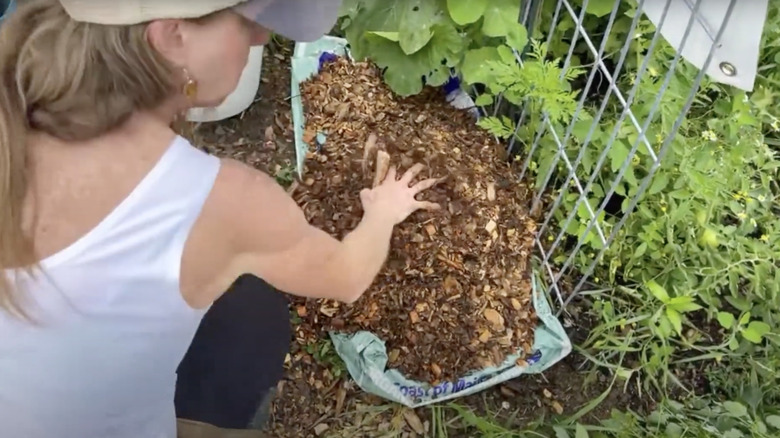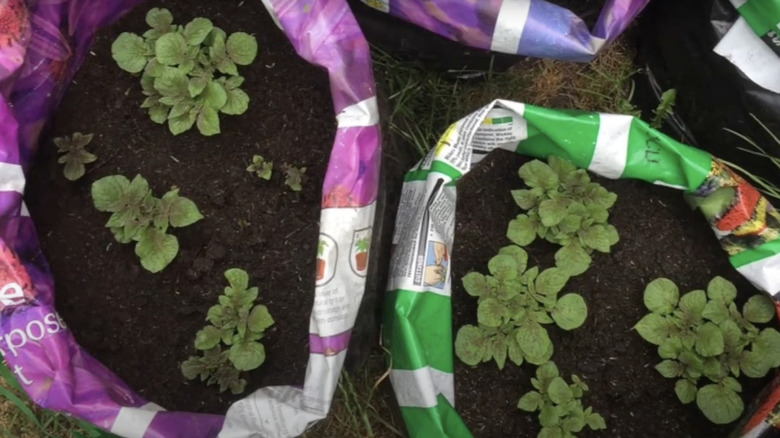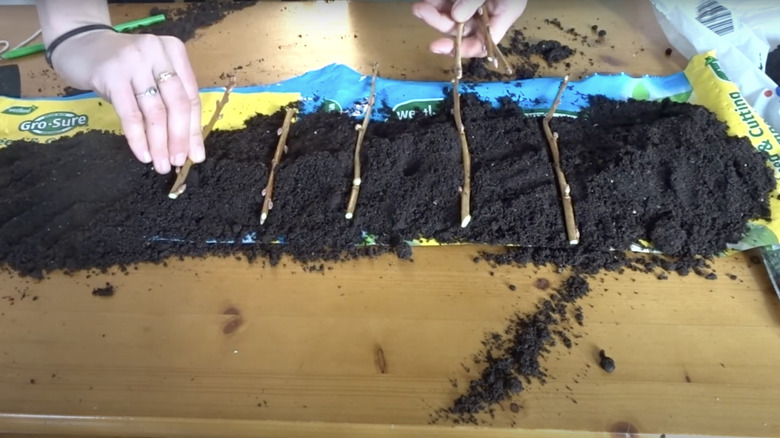Ways To Reuse Soil Or Mulch Bags In The Garden For Less Waste At Home
We may receive a commission on purchases made from links.
After years of tending to your plants, you might have mulching down to a fine art. While the application and maintenance may come easy now, a common mulching mistake you're making in your garden is throwing away all those pesky yet big and durable plastic bags it — or your potting soil — comes in. However, there are several common ways of upcycling them. For example, you can use them as weed barriers, mulch applicators, or emergency frost covers. They can also be used to grow plants (similarly to a plastic grow bag), line hanging baskets, or make compost. If you're really creative, you'll realize these bags make the perfect hauler for everything, from raked leaves to kindling. They can even be repurposed into a planting spacer, sling for shrub transplantation, or a bird deterrent.
Note that many of these ideas are in-a-pinch solutions because in most cases, there's a better quality, purpose-appropriate alternative available. But if you're on a budget, need something temporarily or quickly, or are reusing the bags for ethical reasons, you can try out some of these methods with little harm. Just keep a close eye on them and remove them from your garden as soon as they break down. And they will disintegrate over time because most soil and mulch bags are made of polypropylene — a material that's highly susceptible to damage from the sun's UV light. Wash and dry the bags before you use them, similar to how you'd clean and reuse grow bags in the garden. Just scrub them with soapy water, rinse them with freshwater, and dry them thoroughly indoors.
Using old soil or mulch bags for weed suppression and plant protection
Plastic weed barrier helps suppress wild greenery popping up between vegetable rows, around ornamental shrubs on slopes, or in garden pathways. Cut your soil or mulch bags open and lay them down on the ground, overlapping the edges slightly. Peg them securely in place to keep them from blowing away. Use anything heavy, such as rocks and wood planks as a weight. You could even cover them with soil or get a set of 20 CILLATROO 6-Inch 11 Gauge Anti-Rust Galvanized Landscape Staples.
That being said, these plastic weed barriers come with a few downsides. Since they're non-porous, they can increase water run-off, dry the dirt out underneath the plastic, and reduce airflow and bioactivity in the soil. To mitigate this problem (to a degree), cut holes in the bags or poke holes into them using your garden fork. Another option is to lay some drip tape or soaker hose underneath the opened-out bags. If you hate the look of plastic, spread bark or mulch, like SuperMoss' Coco Mulch in Natural Brown, on top.
Similarly, use empty, opened-up soil or mulch bags as a mulch material in the spring or fall to keep the soil warm and lock in precious nutrients. Not into cutting up the bags? Keep a few sacks aside for when a frost forecast takes you by surprise and pop them over tender shrubs and plants at sunset to protect them from the sudden cold. Remember, this type of non-permeable plastic isn't breathable, so take the bag off come morning.
Plant in old soil or mulch bags, or make compost in them
You can save your empty potting soil bags to expand your small garden. Traditionally, soil bag planting involves cutting a hole in a store-bought bag and planting in it. Do the same with leftover soil bags and reused potting soil or compost. To improve the degraded soil or compost, mix it with an equal volume of new dirt and add a slow release fertilizer. Opaque plastic sacks are ideal for tomatoes and light-shy root vegetables, like potatoes and carrots. They don't have handles like grow bags, so plant them up in their final location. You can also use soil or mulch bags as hanging basket liners. Cut the long sides of the bags to open them up, fit them into the frame (plain side out), and trim off the overhang. Punch drainage holes in the plastic and fill the basket with new potting mix and hanging plants.
Alternatively, reuse the bags to make compost for your garden. Add green — lawn clippings and kitchen vegetable trimmings — and brown organic waste — raked leaves, twigs, and unbleached cardboard — to the bag in layers. Sprinkle in a little water, tie the top of the bag closed, place it inside another bag, and store it in a sunlit section of your garden. Roll the bag to turn the contents every two weeks or so. It should be decomposed and ready to use in your garden within a couple of months to two years, depending on climatic conditions. Already have a thriving open compost pile? Unfurl the bags and use them to shelter said pile from bad weather.
Use soil or mulch bags to soak bulbs, haul raked leaves, and deter birds
Some spring bulbs — think Eranthis, anemone, daylilies, daffodils, tulips, narcissus, hyacinths, and crocuses — benefit from being soaked for up to 24 hours before planting. Place an empty soil or mulch bag inside a large planter, fill it with water (check for leaks) and rooting hormone, if you're using it, and add the bulbs. You can also use them to root hardwood cuttings. Cut the bag in half (lengthwise), layer soil on each half, spread your cuttings evenly along its length, fold the bottom of the sheet upwards, and roll the whole thing up like a jelly roll. Then, turn more bags into planting spacers for said cuttings. Cut holes at regular intervals in the plastic sheet (how far apart depends on what you're planting), peg it to the garden bed, and plant a cutting or seedling in each hole.
If you're struggling to stop feathered garden visitors from nibbling on your lettuces or plucking ripe blackberries from your vines, cut strips from the sheet and hang them on strings you thread across your garden. They'll flutter in the wind, scaring the birds away. Shovel a pile of raked leaves into old soil bags and carry them to your garden beds (as mulch or soil amendment), your compost pile (as a much-needed source of carbon), or give them away. They also make perfect slings for wrapping the delicate root ball of shrubs or small trees dug-up for transplantation and storage. Plus, they can double as stuff sacks for small plastic pots, long handled garden tools, irrigation kits, homemade compost, and kindling or firewood.



